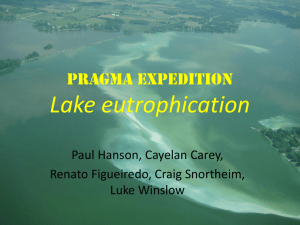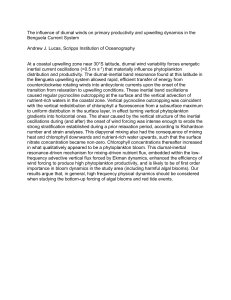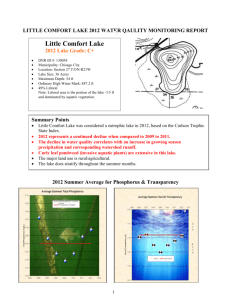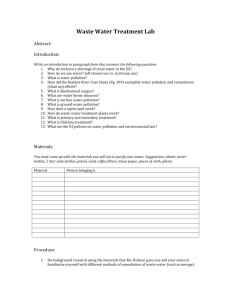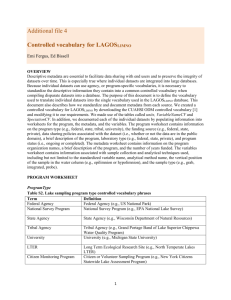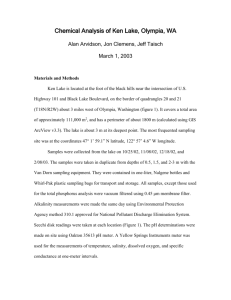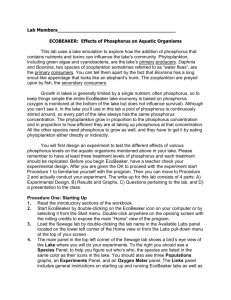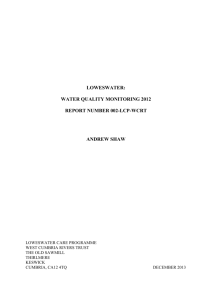Environmental Water Testing 2014
advertisement
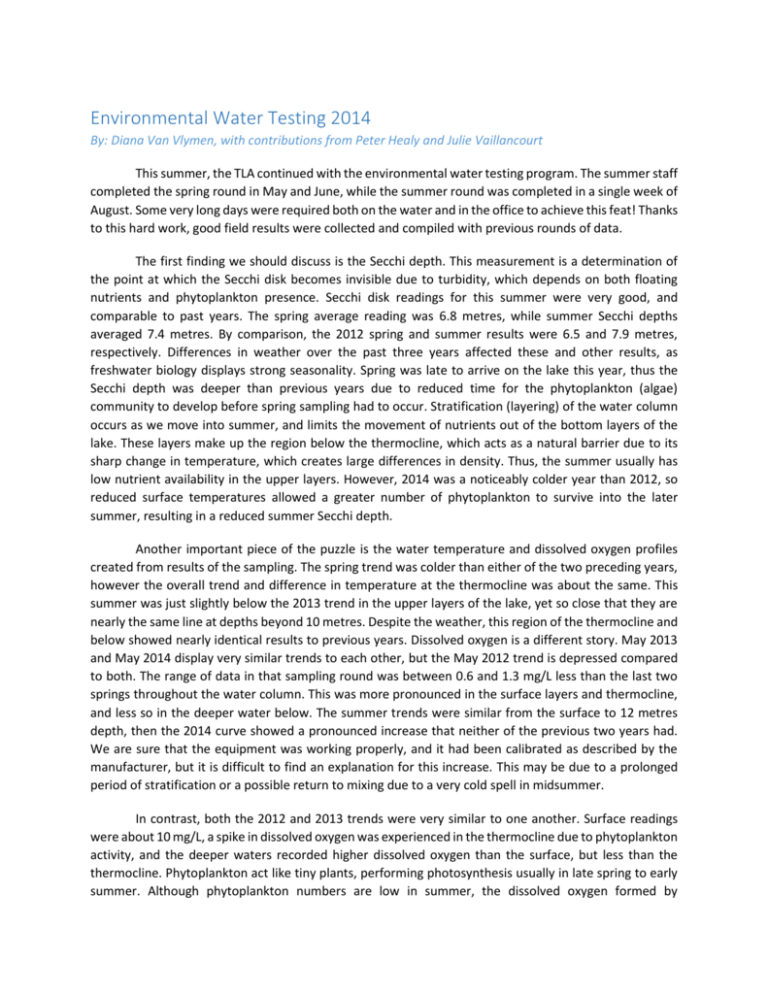
Environmental Water Testing 2014 By: Diana Van Vlymen, with contributions from Peter Healy and Julie Vaillancourt This summer, the TLA continued with the environmental water testing program. The summer staff completed the spring round in May and June, while the summer round was completed in a single week of August. Some very long days were required both on the water and in the office to achieve this feat! Thanks to this hard work, good field results were collected and compiled with previous rounds of data. The first finding we should discuss is the Secchi depth. This measurement is a determination of the point at which the Secchi disk becomes invisible due to turbidity, which depends on both floating nutrients and phytoplankton presence. Secchi disk readings for this summer were very good, and comparable to past years. The spring average reading was 6.8 metres, while summer Secchi depths averaged 7.4 metres. By comparison, the 2012 spring and summer results were 6.5 and 7.9 metres, respectively. Differences in weather over the past three years affected these and other results, as freshwater biology displays strong seasonality. Spring was late to arrive on the lake this year, thus the Secchi depth was deeper than previous years due to reduced time for the phytoplankton (algae) community to develop before spring sampling had to occur. Stratification (layering) of the water column occurs as we move into summer, and limits the movement of nutrients out of the bottom layers of the lake. These layers make up the region below the thermocline, which acts as a natural barrier due to its sharp change in temperature, which creates large differences in density. Thus, the summer usually has low nutrient availability in the upper layers. However, 2014 was a noticeably colder year than 2012, so reduced surface temperatures allowed a greater number of phytoplankton to survive into the later summer, resulting in a reduced summer Secchi depth. Another important piece of the puzzle is the water temperature and dissolved oxygen profiles created from results of the sampling. The spring trend was colder than either of the two preceding years, however the overall trend and difference in temperature at the thermocline was about the same. This summer was just slightly below the 2013 trend in the upper layers of the lake, yet so close that they are nearly the same line at depths beyond 10 metres. Despite the weather, this region of the thermocline and below showed nearly identical results to previous years. Dissolved oxygen is a different story. May 2013 and May 2014 display very similar trends to each other, but the May 2012 trend is depressed compared to both. The range of data in that sampling round was between 0.6 and 1.3 mg/L less than the last two springs throughout the water column. This was more pronounced in the surface layers and thermocline, and less so in the deeper water below. The summer trends were similar from the surface to 12 metres depth, then the 2014 curve showed a pronounced increase that neither of the previous two years had. We are sure that the equipment was working properly, and it had been calibrated as described by the manufacturer, but it is difficult to find an explanation for this increase. This may be due to a prolonged period of stratification or a possible return to mixing due to a very cold spell in midsummer. In contrast, both the 2012 and 2013 trends were very similar to one another. Surface readings were about 10 mg/L, a spike in dissolved oxygen was experienced in the thermocline due to phytoplankton activity, and the deeper waters recorded higher dissolved oxygen than the surface, but less than the thermocline. Phytoplankton act like tiny plants, performing photosynthesis usually in late spring to early summer. Although phytoplankton numbers are low in summer, the dissolved oxygen formed by photosynthesis is unable to leave the thermocline due to density differences, so even a small population has a dramatic impact. These dissolved oxygen results are promising, as the water is consistently more oxygenated than required by any level of the freshwater food web. The final factor with ample data available is phosphorus, for which we collect water samples and send them to the Trent University field lab in Dorset, Ontario after each round of testing. This year’s results averaged 2.6 μg/L at the Secchi depth and 3.5 μg/L at 75% of total depth. This is actually a bit less than the total phosphorus recorded in either 2012 or 2013, and it may be attributed to unusual weather. However, it is more important to note that phosphorus is unlikely to be the same from year to year and that differences in seasons from year to year play a much greater role than isolated weather. This is the purpose of long-term testing – to build a baseline of data that accounts for yearly changes and that we could compare future water quality to, in order to determine whether any significant changes occur over time. For now, it is fair to say that we have not seen any. The newest historical phosphorus graph we have produced shows a line that shows no pronounced changes over the last 10 years, which is excellent where other lakes have not been so lucky. For this reason, it is important that everyone using the lake continues to make an effort to use only phosphate-free soap products, avoid phosphate-containing fertilizers, ensure that greywater leaching pits are in compliance with Ministry of the Environment regulations, and update septic tanks to avoid leaching effluents with high phosphate content into the water. This can be the most significant input of phosphorus into the lake, and it is for this reason that the TLA encourages updating septic tanks installed before about 1975. At this time, steel tanks were used, and most of these tanks have rusted through in the forty years that have passed. The current standard for septic tanks are high-quality plastic that does not rust or degrade, and ensures that no excess phosphorus enters the healthy lake ecosystem that is so precious and increasingly rare. Finally, we would like to introduce a new initiative in the TLA’s testing routine. For the first time this August, samples were collected for chlorophyll a from the surface and the top level of the thermocline. These samples were then filtered back at the TLA headquarters building using a vacuum pump, and sent away to Carleton University with Dr. Murray Richardson for determination of the concentration of chlorophyll a present. This information is very valuable, as chlorophyll a is a more direct measure of phytoplankton present in the lake ecosystem than phosphorus content, dissolved oxygen, or turbidity (all of which are considered indirect measures). Chlorophyll concentration tells us how much phytoplankton IS present in Lake Temagami, where phosphorus tells us how much phytoplankton SHOULD BE present based on standards developed over many years due to phosphorus requirements in relation to phytoplankton community size. While the results are not yet available to be published, look forward to learning more about chlorophyll and reading about our results in a future issue. Overall, Lake Temagami is in excellent shape, we are well on our way to establishing a very strong baseline, and the TLA’s environmental water monitoring has already lasted longer than most. We are taking the next step by incorporating chlorophyll a, which is tested by a limited number of lake associations, and we look forward to what the future holds for our environmental monitoring program.
